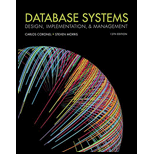
Concept explainers
SELECT statement:
It is used to retrieve information from the table or
SELECT * FROM table_Name;
WHERE clause:
“WHERE” statement is used limit the number of rows. For example: Consider a table “FTable” that has two columns named “FruitName” and “Color”. “WHERE” clause is used when there is a need to display the entire FruitName whose color is Red.
SELECT * FROM FTable WHERE color = 'red';
When the above statement is executed, red colored fruits get displayed.
DISTINCT Keyword:
“DISTINCT” keyword is used to avoid redundant data (removing duplicate values) from a column. The syntax for “DISTINCT” keyword is as follows:
SELECT DISTINCT column_Name FROM table_Name;
ORDER BY Clause:
SQL contains “ORDER BY” clause in order to sort rows. The values get sorted in ascending as well as descending order. The keyword used to sort values in ascending order is “ASC” and for descending order is “DESC”. By default, it sorts values by ascending order.
Syntax:
SELECT column_Name1, column_Name2 FROM table_Name ORDER BY column_Name2;
Trending nowThis is a popular solution!

Chapter 7 Solutions
Database Systems: Design, Implementation, & Management
- using r language Obtain a bootstrap t confidence interval estimate for the correlation statistic in Example 8.2 (law data in bootstrap).arrow_forwardusing r language Compute a jackknife estimate of the bias and the standard error of the correlation statistic in Example 8.2.arrow_forwardusing r languagearrow_forward
- using r languagearrow_forwardThe assignment here is to write an app using a database named CIT321 with a collection named students; we will provide a CSV file of the data. You need to use Vue.js to display 2 pages. You should know that this assignment is similar, all too similar in fact, to the cars4sale2 example in the lecture notes for Vue.js 2. You should study that program first. If you figure out cars4sale2, then program 6 will be extremely straightforward. It is not my intent do drop a ton of new material here in the last few days of class. The database contains 51 documents. The first rows of the CSV file look like this: sid last_name 1 Astaire first_name Humphrey CIT major hrs_attempted gpa_points 10 34 2 Bacall Katharine EET 40 128 3 Bergman Bette EET 42 97 4 Bogart Cary CIT 11 33 5 Brando James WEB 59 183 6 Cagney Marlon CIT 13 40 GPA is calculated as gpa_points divided by hrs_attempted. GPA points would have been arrived at by adding 4 points for each credit hour of A, 3 points for each credit hour of…arrow_forwardI need help to solve the following case, thank youarrow_forward
 Database Systems: Design, Implementation, & Manag...Computer ScienceISBN:9781305627482Author:Carlos Coronel, Steven MorrisPublisher:Cengage Learning
Database Systems: Design, Implementation, & Manag...Computer ScienceISBN:9781305627482Author:Carlos Coronel, Steven MorrisPublisher:Cengage Learning

